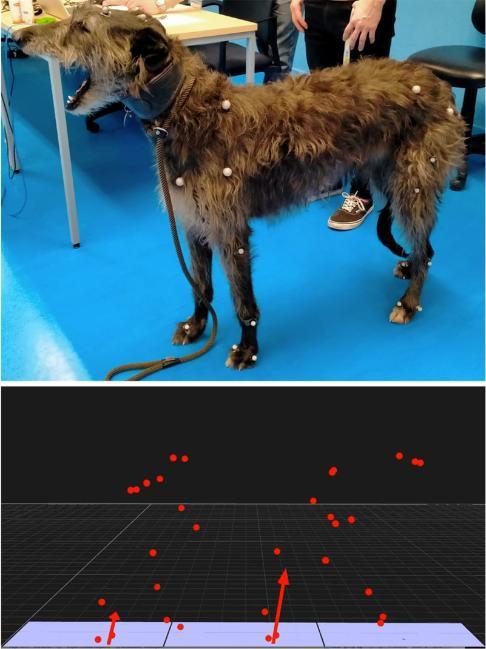The Dog Walk Study
Selective breeding by humans has made the domestic dog the most morphologically diverse species to ever exist.
This morphological diversity, epitomised by breeds as varied as Dachshunds, Great Danes and Pugs, has made dogs popular globally as pets, whilst their functional plasticity has led to breeds ‘optimised’ for tasks as diverse as agility and racing, and working.
However, how these human-induced variations in anatomy and function influence the engineering demands placed on different breeds' bones, joints and muscles, remains poorly understood.
From a scientific perspective, dogs represent an exciting but under-utilised resource: unique morphological characteristics in different breeds mean that dogs can act as a model system to study how anatomical traits influence the mechanics of motion in animals.
Working in collaboration with The Natural History Museum, the Kennel Club, and the BBSRC, the University of Liverpool has launched The Dog Walk Study to better understand the challenges around canine morphology and how it could influence the future of breeding and clinical veterinary care.
The Dog Walk team are currently seeking dog volunteers to participate in a new study, focussed specifically on dogs with mobility impairments in their legs that impact their movement.
Please scroll down to the New study section for more information and details on how to register.
Understanding Movement
The aim of this project is to investigate links between variations in morphology and walking mechanics in domestic dog breeds using a combination of statistical shape analyses methods developed by comparative biologists, and motion analysis and biomechanical modelling typically used by engineers.
Our state-of-the-art Gait Lab, based in the William Henry Duncan Building of the University of Liverpool, allows us a unique opportunity to develop graphics like the one below, reconstructing the movement of our subjects in great detail.
Influencing the Future
This new research is timely given growing concerns about the welfare implications of selective breeding in dogs and fears that many anatomical traits may place unnatural engineering demands on their bones and joints thereby creating predisposition to disease and injury in certain breeds.
Our work will contribute scientific data that can be used in the future to improve canine breed practices and better inform veterinarians on treatments and the design of breed-specific joint replacements.
Our progress so far
The Dog Walk Study kicked off in September 2023 and the over the past 12 months we have collected movement data on more than 110 dogs from 12 different breeds in our Liverpool gait lab! See the graph below for a breakdown of the dogs that have participated, and the image of one of our participating Deerhounds alongside some of their motion data. These numbers have exceeded our expectations, and we owe a huge thanks to the owners (and dogs) that have given up their time to participate in the research. The 12 breeds we have collected data on provide with the range of body sizes and shapes we need to the investigate links between variations in morphology and the mechanics of movement in domestic dogs (ranging from 4.6kg Dachshund to a 62kg Great Dane!). However, we are still looking to recruit Great Danes, Beagles and West Highland White Terriers (WHWT) to achieve our goal of having a minimum of 5 dogs in each breed. Information on how to participate in the research is provided below.

Graph showing the number of dogs in each of the 12 breeds to have participated in locomotion research at the University of Liverpool. 114 dogs have participated so far.
One of the volunteer Deerhounds with spherical motion capture markers attached to various anatomical locations across the body (top image). The 3D movements of these markers are tracked by 12 motion capture cameras while the dogs perform different moving tasks across force plates (purple squares in lower image), which measure ground reaction forces (red arrows in lower image).

Meanwhile at the Natural History Museum we have started making 3D models of the limb bones (humerus, radius, ulna, femur, tibia & fibula) of each of these dog breeds using existing CT scans from the Liverpool Vet School. We have also been 3D scanning limb bones housed in the collections of the Natural History Museum. Currently we are in the process of analysing the shape of all these bones to find out the differences (if any!) in limb bone shape between dog breeds, as well as looking at how bone shape changes with age. So far we have completed preliminary analyses on the femur and humerus: femur shape is relatively similar across all breeds plus the wolf (see left image below), whereas humerus shape varies more amongst breeds (right image below).

Femora (left) and humeri for six of the breeds of interest compared with the wolf Canis lupus. Scaling bones to the same size enables us to see differences in shape between the breeds.
New study - Volunteers needed
The Dog Walk team are currently seeking dog volunteers to participate in a new study, focussed specifically on dogs with mobility impairments in their legs that impact their movement.
What will my dog need to do?
Dogs will be asked to perform walking trials in our purpose-built biomechanics lab at the University of Liverpool main campus in Liverpool. We will measure the motion of their joints using skin markers, sensors, cameras and x-ray methods.
Who can take part?
We are looking to recruit young, healthy dogs from the following breeds: German Shepherds, Labradors, Cocker Spaniels, Springer Spaniels, Dachshunds, West Highland White Terriers, French Bulldogs, Border Collies and Beagles. They need to be at least 1 year old but younger than 8 years old, with no signs of health problems that affect their movement. Your dog must currently be going for walks of between 30-90 minutes a day and should be a good healthy weight. They should also be happy to be handled and do some basic tasks: standing still, and walking and trotting in a straight line.
If your dog meets this criteria, contact the team to register for the dog walk study.
All participants will receive a £10 Amazon voucher per visit.

This project will help us understand the impact of selective breeding on canine anatomy and musculoskeletal health. We will analyse how the anatomy and movement of a dog's skeleton changes during its growth, particularly in different breeds. By tracking these growth trajectories, we hope to shed light on potential links between specific breeding and growth patterns and the development of musculoskeletal health issues in dogs as a result.





